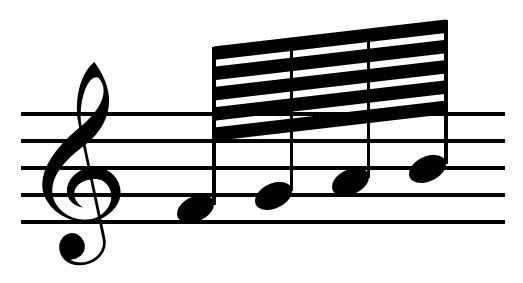 | ||
In music, a hundred twenty-eighth note or semihemidemisemiquaver is a note played for 1⁄128 of the duration of a whole note. It lasts half as long as a sixty-fourth note. It has a total of five flags or beams.
Notes this short are very rare in printed music, but not unknown. They are principally used for brief, rapid sections in slow movements. For example, they occur in the first movement of Beethoven's Pathétique Piano Sonata (Op. 13), to notate rapid scales. Another example is in Mozart's Variations on Je suis lindor, where many of them are used in the slow twelfth variation.
These five-beamed notes also appear occasionally where a passage is to be performed rapidly, but where the actual tempo is at the discretion of the performer rather than being a strict division of the beat. In such cases, the aggregate time of the notes may not add up exactly to a full measure, and the phrase may be marked with an odd time division to indicate this. Sometimes such notation is made using smaller notes, sized like grace notes. One rare instance where such five-beamed notes occur as acciacaturas occurs in the final measures of No. 2 of Charles-Valentin Alkan's Trois grandes études, Op. 76.
Hundred twenty-eighth rests are also rare, but again not unknown. One is used in Beethoven's Piano Sonata No. 13 "Quasi una fantasia" (b. 24 in the slow movement).
The names of this note (and rest) vary greatly in many languages:
